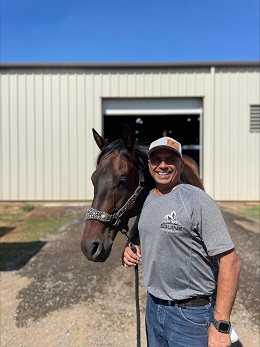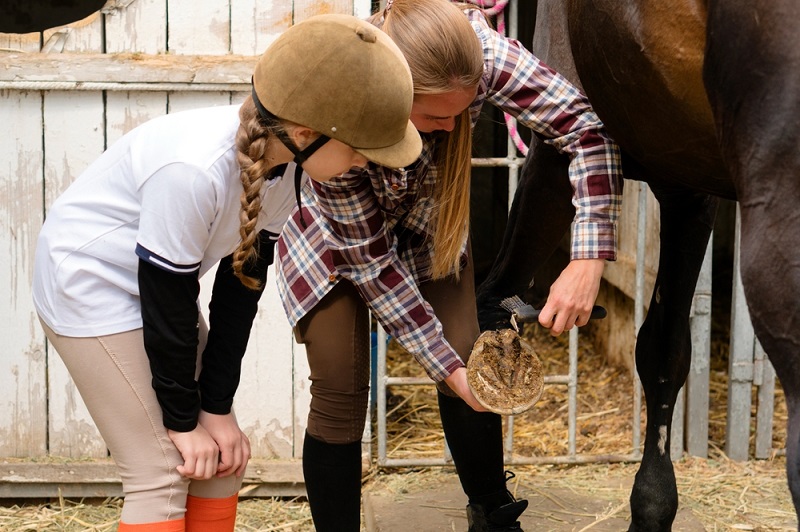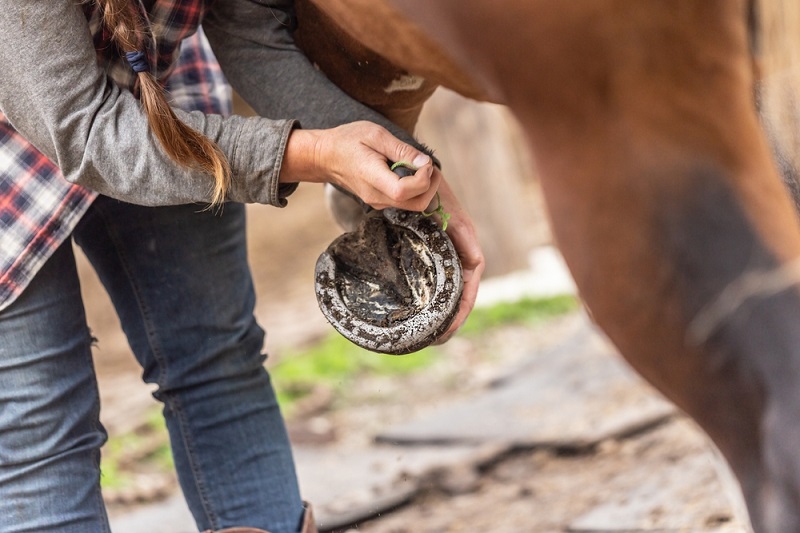Horses spend all day on their feet, so it should come as no surprise that they need their hooves cleaned regularly. Think about all the mud, dirt, and stones that get stuck in your boots over time. Now imagine not cleaning your shoes, letting all that debris pile up, and never being able to take your boots off, even when you’re done working. That’s what it’s like for a horse whose hooves aren’t cleaned.
Horses carry us on their backs, and you want to pay proper attention to the hooves that support you both throughout the day. While you can rely on an experienced farrier to handle in-depth cleaning and medical attention, in the time between these visits, you should take the reins on regular horse hoof cleaning. Cleaning horse hooves will ensure that your horse stays happy and healthy, as well as avoid serious hoof problems and issues in the long run.
Take a look below at our comprehensive horse’s hoof guide to discover how to incorporate hoof cleaning into your everyday routine, tips and tricks on your horse’s hoof maintenance, and preventative care measures.
Why Should You Regularly Clean Horse Hooves?
Hoof cleaning is a crucial part of daily horse grooming. It allows you to routinely assess your horse’s health, so you can spot any issues before they become too serious. Plus, regular care and a healthy hoof routine create bonding time for you and your horse.
One of the most important benefits of cleaning horse hooves is that it keeps horses properly balanced, so their hooves land evenly and squarely while walking. You should also check for a straight line from the pastern to the front hoof, as well as adequate heel support.
Without adequate hoof cleaning, your horse will be off-balance on its feet, which can cause1:
- Slower movement
- Stress on bones and joints
- Strain on tendons and ligaments
On the more severe side, regular hoof cleaning can also help prevent infection and injury.
Common Hoof Problems
Hoof cleaning and maintenance help prevent both short- and long-term health issues. Plus, if anything is wrong, daily check-ups mean you’ll be able to take action faster.
Without proper grooming and healthy hoof care, horses can develop a range of health problems, including1:
- Thrush – Signs of this hoof condition include a foul odor and black discharge. Over time, horse thrush deteriorates the hoof and can cause lameness. While hoof cleaning is one method to prevent infection, thrush can also be avoided by keeping your horse out of wet or muddy terrain and ensuring their stalls are dry.
- Abscesses – An abscess is a severe buildup of pus caused by bacteria from stone bruises, punctures, or other infections. If untreated, it can cause sudden or prolonged lameness. A hoof soak followed by a dry bandage is typically the recommended treatment, though you should always consult your veterinarian when looking at how to heal abscesses in horse hooves.
- Hot nail – If a horse is shod, nails from the horseshoe can become loose and penetrate the hoof, causing discomfort and increasing the chance of infection.
- Street nail – If hooves are not regularly cleaned, they can become impacted by twigs, rocks, or other debris. When a foreign object punctures the hoof, the resulting damage is called street nail.
- White line disease – Also known as seedy toe, this infection is caused by a crack or separation in the hoof wall, which allows harmful bacteria to enter. If left untreated, white line disease in horses can damage the hoof to the point of laminitis in horses or lameness.2
Accidents can happen, but everyday hoof cleaning can go a long way in minimizing the risk of these hoof issues.
Hoof Cracks
Another side effect of inadequate cleaning is hoof cracks. Of course, an unexpected blow or fall can crack a hoof, but barring serious circumstances, regular hoof cleaning and moisturizing may also minimize the risk of cracks.
A well-maintained hoof is less likely to suffer from various types of hoof cracks, such as:
- Grass cracks
- Sand cracks
- Bar cracks
- Quarter cracks
Faulty shodding and infrequent hoof trimming can also cause hoof cracks, as can abscesses, inflammation, and external trauma. If you regularly clean your horse’s hooves and notice chronic or serious cracking, you should consult a farrier.
How to Clean a Horse’s Hooves
With consistent practice and the right supplies, cleaning your horse’s hooves can and should be a smooth, pain-free process. Here are the eight steps to follow.
1. Prepare a Toolkit
Your tack room should be well-stocked with everyday grooming necessities. For hoof cleaning, all horse owners need:
- A hoof pick
- A stiff brush
- A hoof knife
- A conditioner or sealant, like Vetericyn Hoof Care
- Gloves
These are the basics of daily hoof care. Professional hoof trimming tools are usually only used by farriers, who your horses should see regularly—every 6 to 8 weeks in the summer, and every 6 to 12 weeks in the winter.1
2. Tie Up Your Horse
Use a halter or rope to secure your horse during the cleaning process. This not only keeps them from running off, but also helps prevent them from injuring you with an accidental kick if they become irritated or scared.
3. Get into Position
Never stand directly in front of or behind a horse while cleaning their hooves. You should be next to your horse’s shoulder, facing their tail.
4. Lift the Foot
Start by gently but firmly holding your horse’s ankle, signaling them to lift their foot themselves. Many horses will have this instinct, making it easy to begin cleaning.
If your horse doesn’t respond to a lifting cue, apply gentle pressure to the fetlock to encourage the motion. If that doesn’t work, you can lightly lean against your horse’s side, causing them to shift their weight onto the other leg and allowing you to more easily lift the hoof on your side.3
5. Clear Out Debris
With a hoof pick, begin clearing away all the built-up detritus. Start at the heel and work toward the toe. Use a stiff brush to remove any remaining dirt. Make sure to fully clean out the collateral groove as well as the line between the sole and the frog, where debris is especially prone to caking up.
6. Check the Shoes
Give your horse’s shoe a once-over to ensure there are no missing nails, loose sections, or risen clenches.3
7. Apply a Hoof Treatment
A hoof care treatment forms a protective barrier between your horse’s hooves and the elements beneath them. If horses consistently walk on wet grass or mud, their hooves can become a breeding ground for infectious pathogens—so protection is paramount.1
Check out these care formulas from Vetericyn:
- Hoof Care spray – Our Hoof Care formula is designed to keep harmful bacteria and microorganisms at bay. The spray penetrates deep into the hoof, creating a protective, antimicrobial barrier. In the process, it may also support hoof health such as hoof repair and healthy tissue growth. Plus, the bright blue dye makes it easy to tell when the product has worn off and it’s time for reapplication.
- Hoof Soak – Our concentrated Hoof Soak can be used for horses exposed to poor environmental conditions, such as prolonged rain or mud. This concentrated formula targets harmful microorganisms that build up inside the hoof cavity. Simply soak the hooves for 40 to 60 minutes and leave the product on without rinsing it off.
Other hoof treatments you may want to explore include conditioners, sealants, and moisturizers.
8. Repeat
Continue these steps on the other three hooves. Even if you never notice any issues on certain hooves, it is best to play it safe and care for each hoof proactively, rather than reactively.
More Ways to Promote Hoof Health
In addition to daily hoof cleaning, there are many other routines to promote hoof health and keep your horse in tip-top shape:
- Avoid inclement weather – Rain, snow, mud, and wet fields are a recipe for infections like thrush. If you can’t avoid getting a horse’s hooves wet, make sure to thoroughly dry them off before going inside.
- Keep a clean, dry stable – Standing in water, mud, or feces invites bacteria into a hoof and is a major cause of white line disease. Be sure to muck out stalls every day and lay down fresh, dry hay.
- Provide proper nutrition – Just like people, horses need a well-balanced and nutritious diet to stay healthy. Always supply high-quality hay and fresh water. Plus, research shows that hooves can benefit from additional vitamins and minerals such as biotin, iodine, and zinc.1 Talk to your veterinarian about incorporating supplements into your horse’s diet.
Remember: The hooves are a horse’s foundation. When they’re strong and healthy, your horse can walk more confidently and resiliently over whatever terrain is ahead.
Maintain Healthy Hooves with Vetericyn
Regular hoof maintenance is a must for every horse owner’s daily routine. At Vetericyn, we’re committed to high-quality equine products that keep you in the saddle and your horse on the trail.
From products that support hoof health to expertly formulated shampoos and liniment, we’ve thought of everything you and your horse need.
Stock up on Vetericyn products today at your local animal supply store, or order online from Amazon or Tractor Supply to have them delivered straight to your door.
 Reviewed by Solomon Benarroch, Veterinarian
Reviewed by Solomon Benarroch, Veterinarian
Solomon Benarroch DVM has been a practicing veterinarian for over 30 years. His primary focus has been in equine soundness and performance sports medicine. Originally from Winnipeg, Canada he attended college at the Western College of Veterinarian Medicine. And completed an internship at the University of Minnesota. He is the father of three kids and when he isn’t working (which is rare), he enjoys traveling, cooking, and spending time with friends and family.
Sources:
- University of Minnesota Extension. Caring for your horse’s hooves. https://extension.umn.edu/horse-health/caring-your-horses-hooves
- American Quarter Horse Association. White line Disease: Identifying, Treating and Preventing. https://www.aqha.com/-/white-line-disease
- EQUUS. How To Clean A Horse’s Hooves. https://equusmagazine.com/horse-care/hooves-10210

